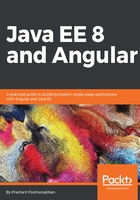
Summary
As you may have noticed, getting started with JPA and CDI isn't that complex. With an understanding of both, it's possible to build large applications which utilize these technologies for various business cases. We looked at how dependency injection promotes writing loosely coupled and testable code and how CDI, a ubiquitous API for dependency injection and context management in Java EE, helps us do that.
CDI 2 brings ordered and asynchronous events to further enrich this programming model. As of the 2.0 release, CDI is available for Java SE as well. JPA has been updated for utilizing Java 8 Streams, repeatable annotations, and date/time APIs along with better CDI integration support. The JPA entities are defined as classes using @Entity, @MappedSuperclass, and @Embeddable annotations. To track state changes, we get to use entity listeners that can be used with CDI as well. Bean Validation 2.0 can be leveraged when defining constraints on JPA entities; this declarative method makes adding validations a fairly easy task to do.
Having learnt about CDI and JPA, which are two fundamental APIs that are used for building Java EE solutions; we can now switch our focus to microservices as we explore API-driven architecture.